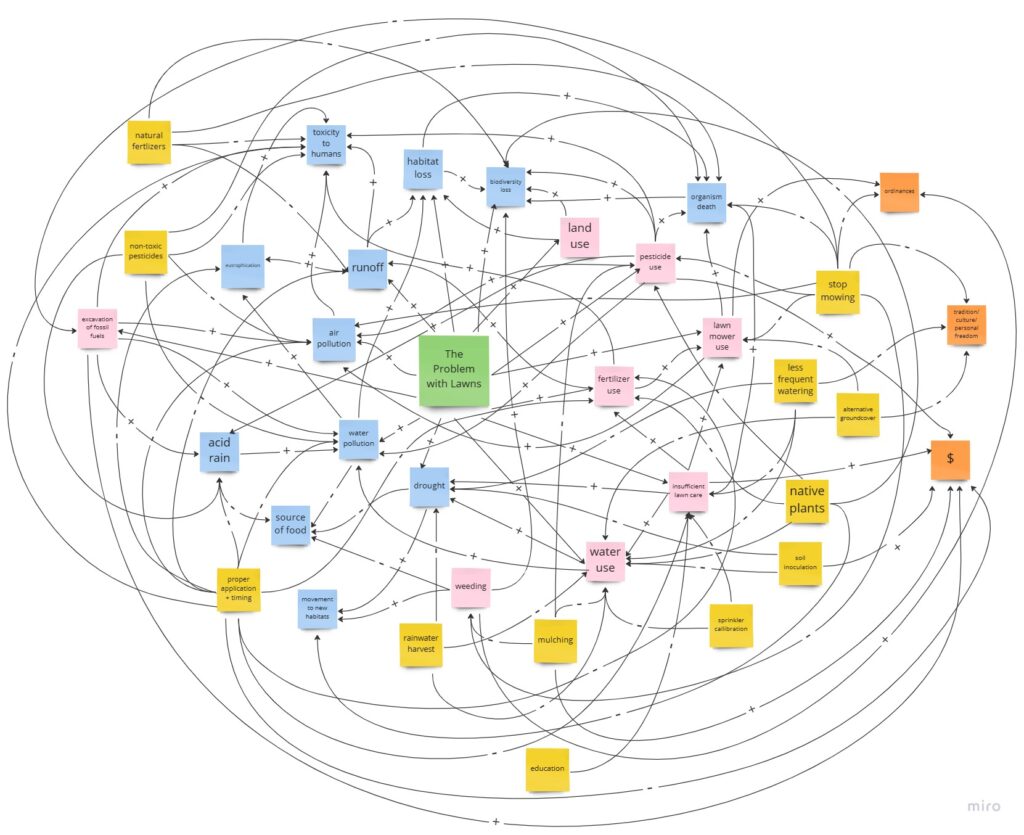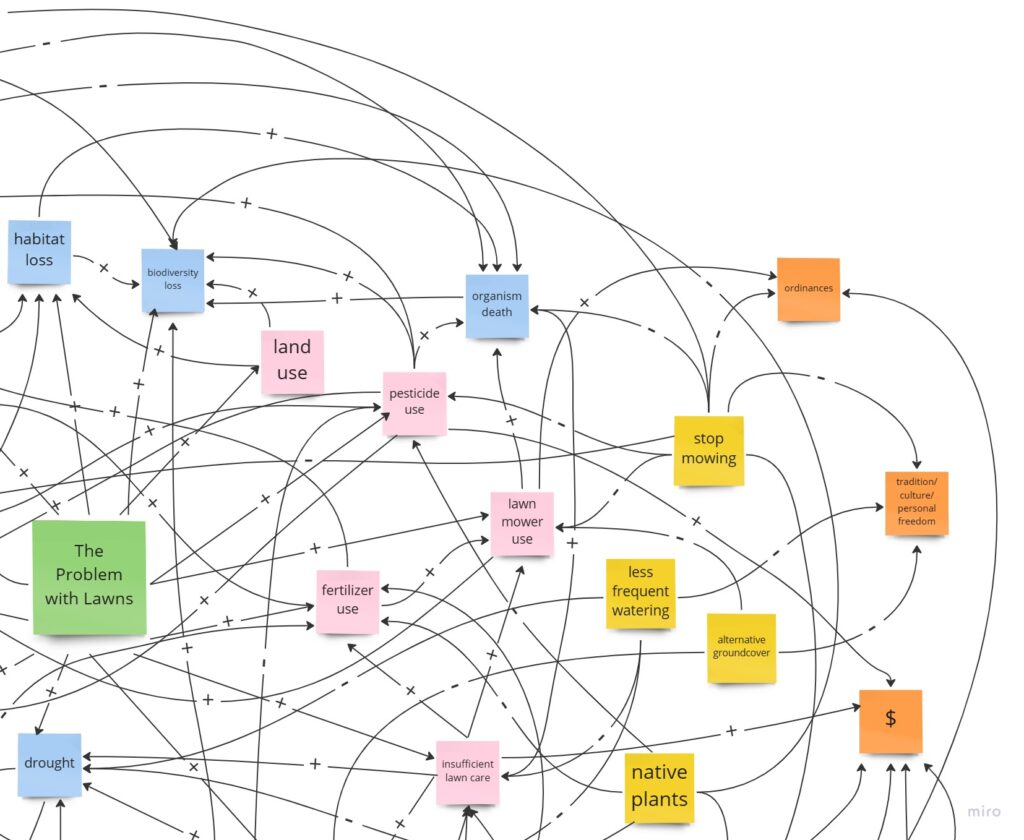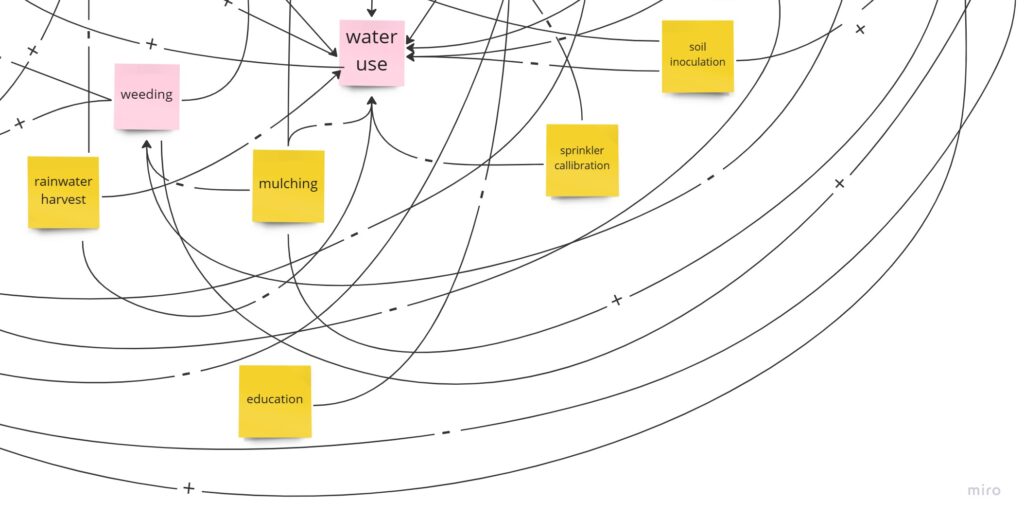Applying Systems Thinking
In a time of widespread drought, extinction, and climate change, the practice of maintaining lawns is beginning to experience scrutiny. Lawns are usually non-native and require large quantities of water along with the consistent application of pesticides and fertilizers to survive. Turf grass yards pose very minimal benefits to the environment, yet they make up over 40 million acres of the United States’ terrain. More land is dedicated to lawns than to life-sustaining crops like corn and wheat.1 Since grass turfs are monocultures and low growing, they do not serve as adequate habitats for insects and small mammals. Lawns are direct contributors to the loss of biodiversity and must be modified to prevent the demise of keystone species like pollinators. The pesticides that are used on lawns are typically broad-spectrum and pose threats to beneficial organisms. About 99.9% of pesticides reach a destination that is not its target, so they can easily contaminate the air, waterways, personal belongings, and land.2 Most pesticides used in household settings pose toxicity to pets and humans and require proper storage and application in order to be safe/effective. Grass fertilizers require adequate timing as well, since they can easily be washed away by rainfall if not completely dried. When these fertilizers are washed away, they increase levels of harmful runoff– which is a major cause of water pollution and eutrophication. The use of gasoline-powered mowers (and other lawn equipment) emits toxic chemicals into the air, which can secondarily lead to consequences like acid rain and air pollution-related diseases and deaths. Americans spend exorbitant amounts of money on lawn care each year, so the switch to more sustainable yards can help millions of people save or reallocate their earnings.
In order to fully understand the issue of lawns and everything they can impact, it is important to view it from an integrative standpoint. To do this, a process called systems thinking can be implemented to visualize the relationship between the potential causes, negative effects, solutions, and barriers associated with lawns and their upkeep. In the following diagram, the leading causes of unsustainable lawns are highlighted in pink, the potential effects in blue, available solutions in yellow, and possible barriers in orange (see Figure 1). Based on the amount of arrows strewn across the concept map, it is clear that the issue of grass lawns has a noticeable influence on several different aspects of the environment, and therefore requires a multifaceted approach to see universal progress. After analyzing the main components that go into making a lawn unsustainable, I began to explore options to alleviate the issue at hand. These solutions include less frequent watering, implementing alternative groundcover and native plants, using natural fertilizers and non-toxic pesticides, reducing or eliminating mowing, properly timing the application of lawn chemicals, mulching, harvesting rainwater, calibrating sprinklers, and inoculating the soil for yards to better-retain water and nutrients. Barriers to achieving sustainable yards include tradition and culture, personal freedom, money expenditure, and government-enforced ordinances.
From a wider perspective, lawns can be made more sustainable through the work of policies and incentives. For example, House Bill 4245 was presented to the Illinois General Assembly in January of 2023 with goals of enforcing better regulations on home irrigation systems. This bill states that upon the installation of a new sprinkler system for lawn care, its function must be inspected by a licensed plumber. With this in effect (as of February), state representatives like Jay Hoffman anticipate that there will be a reduction in accidental sewage leaks, toxic emissions, and insufficient yard maintenance linked to faulty backflow. Violations of this bill could result in financial penalties of up to $10,000 USD.3 Drought-ridden states like Colorado have been pushing for the ban of non-native grasses as an effort to reduce unnecessary water use. These regulations are known as “turf replacement programs” and work by paying homeowners for every unit of grass they replace with less consumptive ground cover.4 Bills like this have great potential for improving biodiversity and reducing the water footprint of our communities. Simple changes such as turf replacement can induce multi-level changes to the environment, economy, and our culture.
Policies enacted by homeowner associations (HOAs) are sometimes controversial, since they often prioritize visual aesthetics over what is optimal for the health of our ecosystems. Generally, HOA policies have requirements such as approved plant species, limitations on lawn furniture and decorations, garden restrictions, as well as rules on tree removal and fence installation.5 Shifting the focus from superficial appearance to environmental sustainability within these homeowners associations can help to cultivate neighborhoods with more creative freedom, healthier gardens, and less dependency on resources like water and pesticides.
As I was researching potential solutions and their interactions, I realized that a great deal of them begin at the individual level. There are limitations to embracing a free-growing yard- as many cities and towns enforce regulations stating that lawns must be trimmed to certain heights and thoroughly weeded. Some individuals may prefer traditional lawns and be hesitant to make their outdoor property more beneficial to the environment. Another potential barrier to achieving lawn sustainability are financial concerns. Certain practices like soil inoculation, mulching, and buying commercial pesticides and fertilizers listed as non-toxic/organic can lead to additional or more expensive purchases. There is a chance for these barriers to be overcome. Educating individuals about the consequences of traditional lawn care while offering them a wide range of accessible solutions is one of the first steps that should be taken towards the naturalization of monoculture lawns. Working with city councils to modify unsustainable ordinances can encourage others to embrace that change as well. As for the financial barriers, it is important to think of the spending relative to preventing harmful things like pesticide and pollution induced diseases, the excavation of fossil fuels, and biodiversity loss. Alternative, more sustainable products are not always more expensive, and some can even be sourced from household food waste and yard clippings. Promoting changes in policy at the local, regional, national, and international levels can also help consolidate many of the issues associated with traditional landscaping.
With systems thinking in mind, it is important to visualize the causes, consequences, solutions, and barriers of lawn care in a holistic manner that considers multiple perspectives. There are many initiatives to be taken at a household level, but compliance with all levels of society and the government is necessary to adequately address the problems that traditional lawns pose to our environment and its inhabitants. Transitioning to a society that embraces new innovations and sustainable practices is one of our most central ways of combating our current economic, environmental, and socio-political crises.
Figure 1:





Sources:
Exposure to Pesticides, Herbicides, & Insecticides: Human Health Effects. The Institute for Functional Medicine. https://www.ifm.org/news-insights/exposure-pesticides-herbicides-insecticides-human-health-effects/.
Hensel A. 2023 Jan 9. Illinois General Assembly approves regulation impacting lawn sprinkler system installation. wrexcom. [accessed 2023 Mar 4]. https://www.wrex.com/news/illinois-general-assembly-approves-regulation-impacting-lawn-sprinkler-system-installation/article_2a1b2f87-a789-5f82-a6b8-8b14f5f43d4f.html.
Sundberg M. 2017 Jul 15. Our Lawns Are Killing Us. It’s Time to Kick the Habit. Ecological Landscape Alliance.https://www.ecolandscaping.org/07/installing-and-maintaining-landscapes/lawn-care/lawns-killing-us-time-kick-habit/.
Square AH | TC. Illinois General Assembly approves regulation impacting lawn sprinkler system installation. WREX. [accessed 2023 Mar 4]. https://www.wrex.com/news/illinois-general-assembly-approves-regulation-impacting-lawn-sprinkler-system-installation/article_2a1b2f87-a789-5f82-a6b8-8b14f5f43d4f.html.